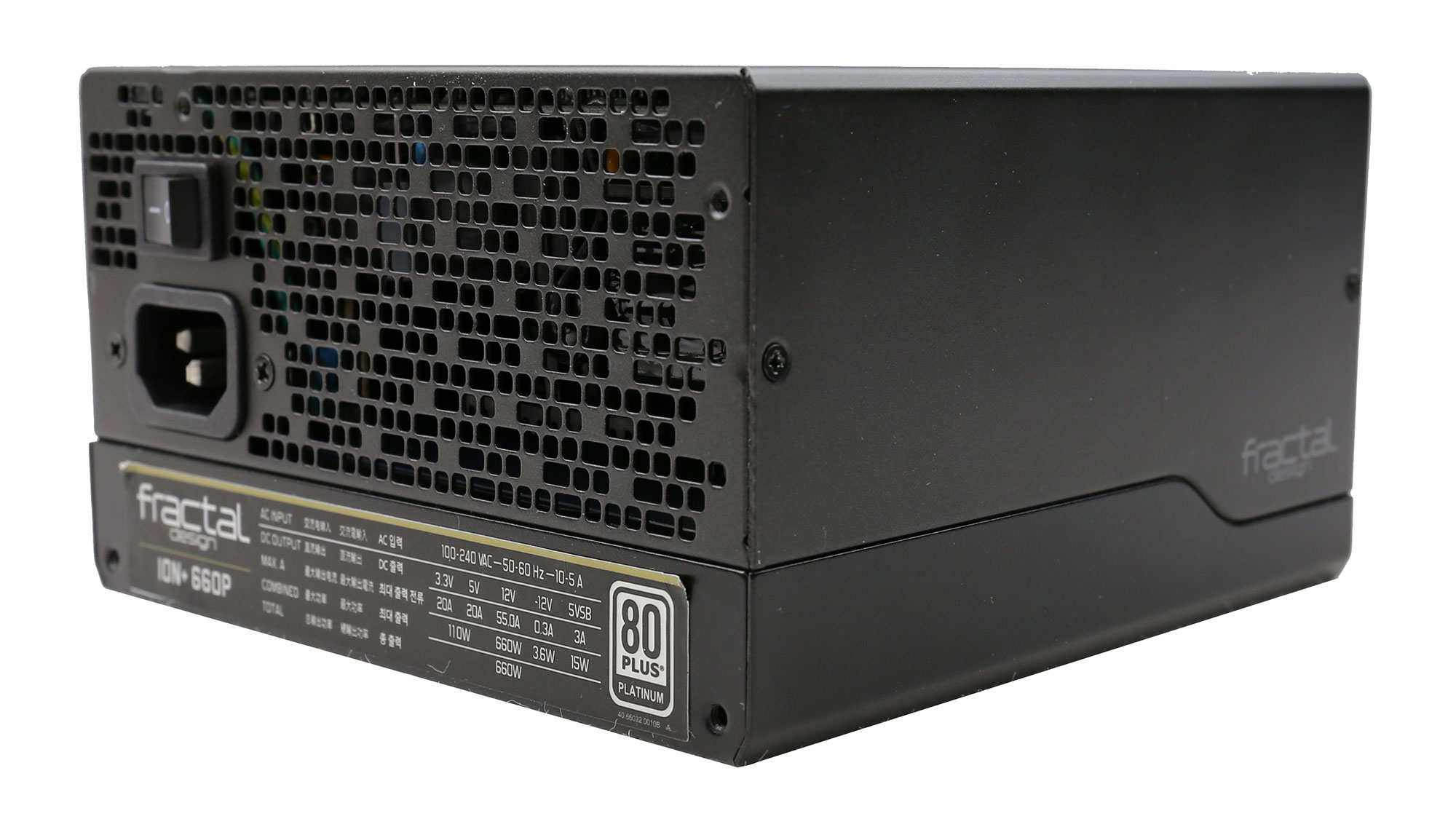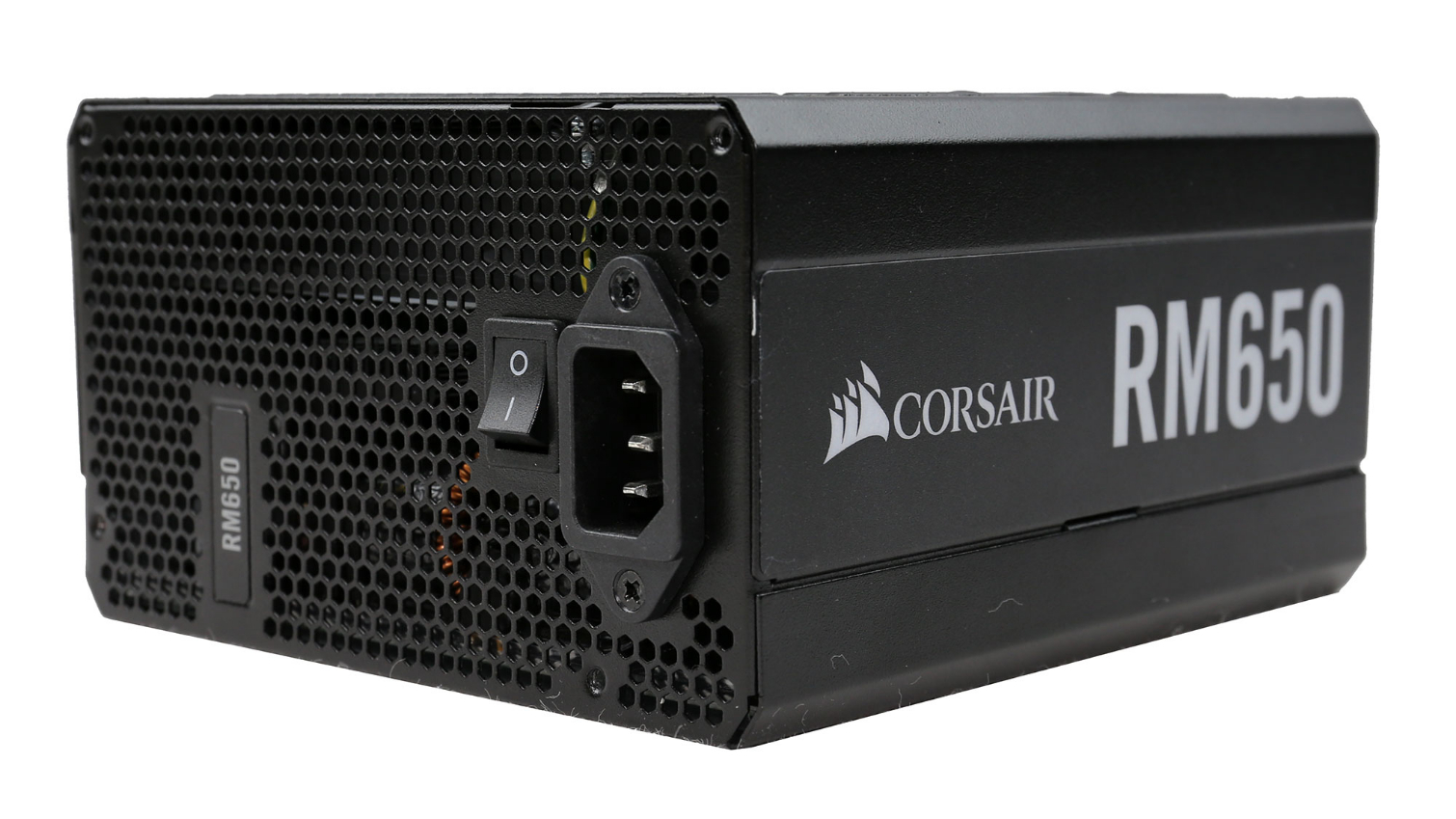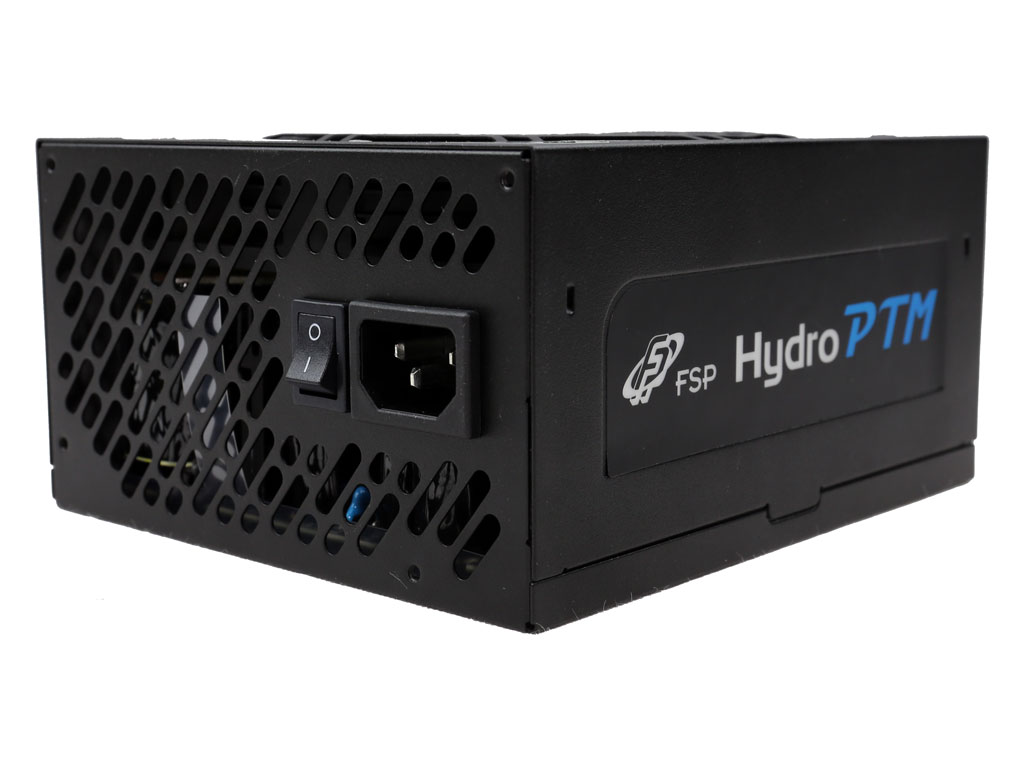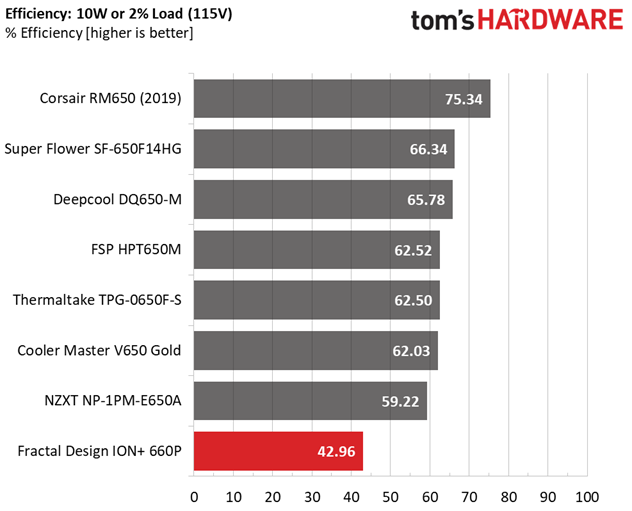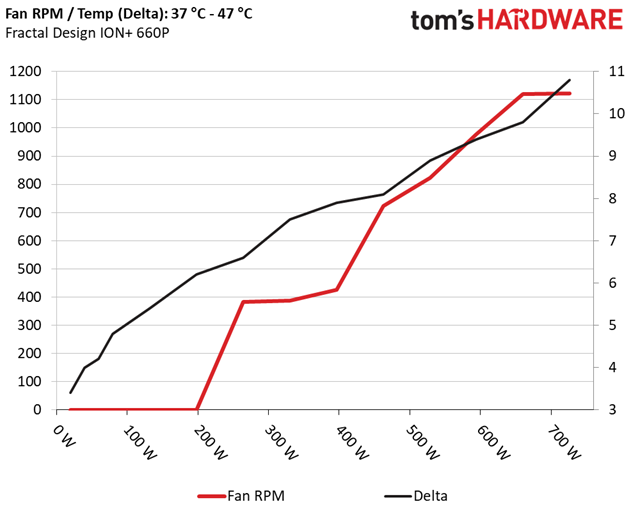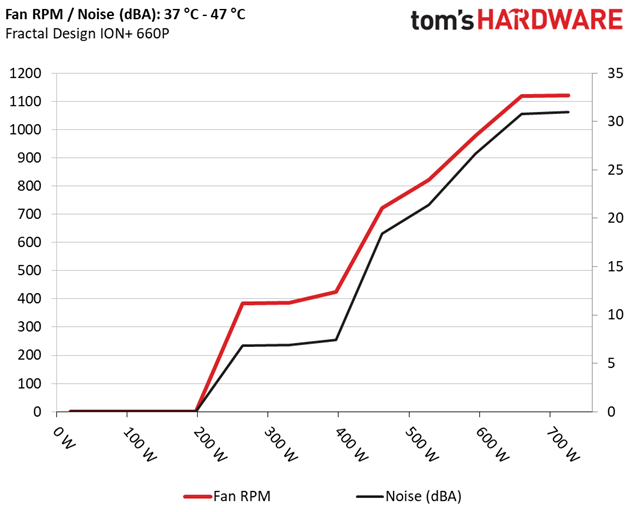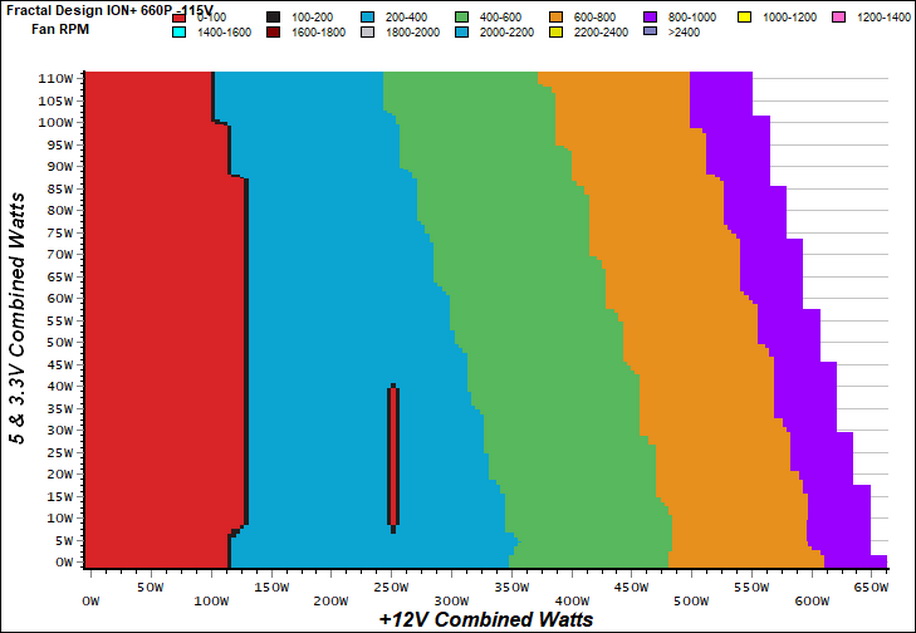Fractal Design ION+ 660P Power Supply Review: Compact And Silent
Why you can trust Tom's Hardware
Load Regulation, Hold-Up Time, Inrush Current, Efficiency and Noise
To learn more about our PSU tests and methodology, please check out How We Test Power Supply Units.
Primary Rails And 5VSB Load Regulation
The following charts show the main rails' voltage values recorded between a range of 40W up to the PSU's maximum specified load, along with the deviation (in percent). Tight regulation is an important consideration every time we review a power supply because it facilitates constant voltage levels despite varying loads. Tight load regulation also, among other factors, improves the system’s stability, especially under overclocked conditions and, at the same time, it applies less stress to the DC-DC converters that many system components utilize.

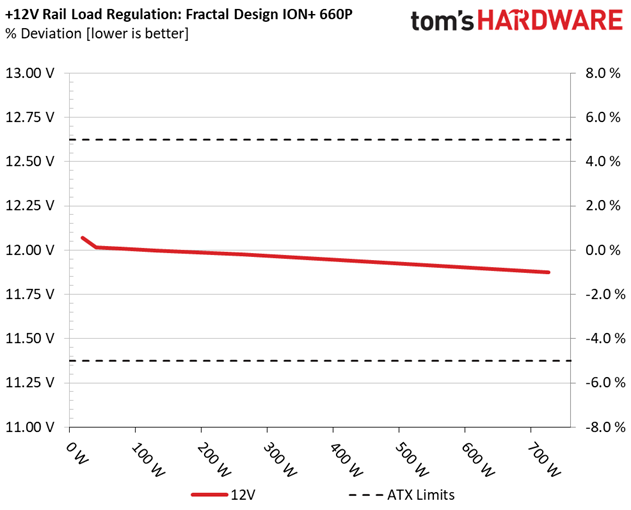
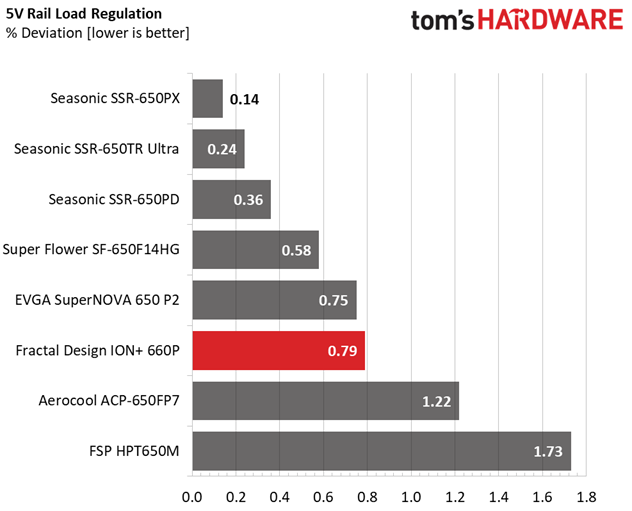
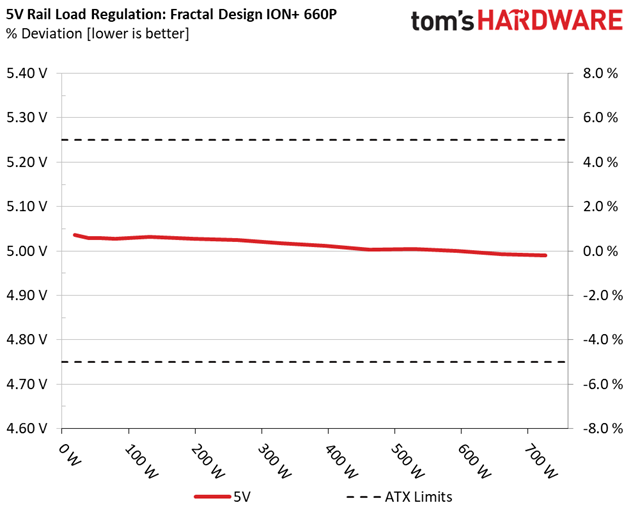
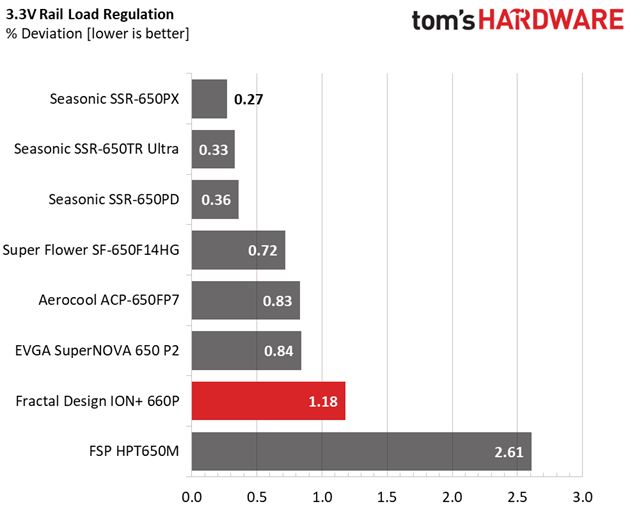
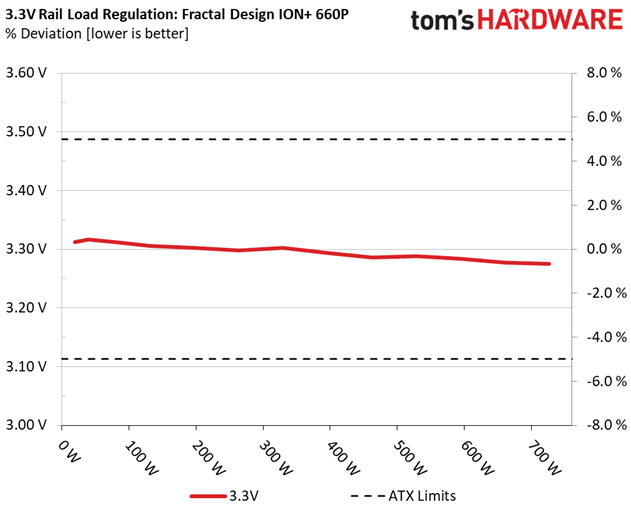
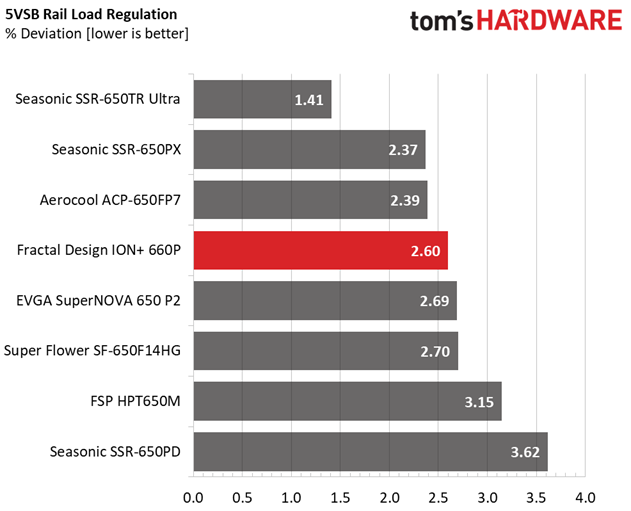
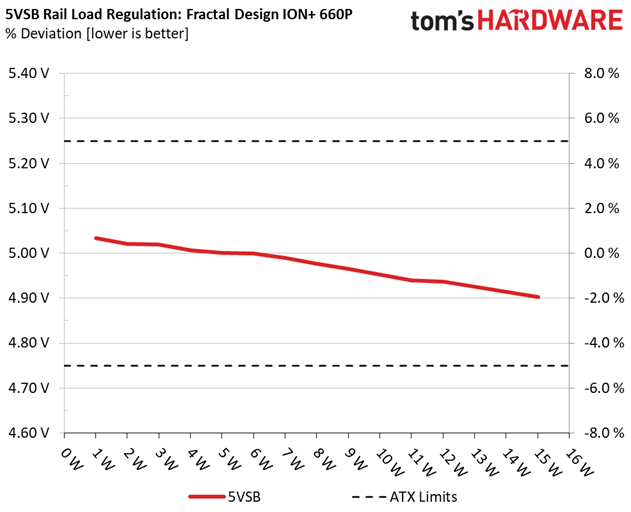
The load regulation at +12V is not so tight. On the 5V and 5VSB it is satisfactory, while at 3.3V we would like it to be within 1%.
Hold-Up Time
Put simply; hold-up time is the amount of time that the system can continue to run without shutting down or rebooting during a power interruption.
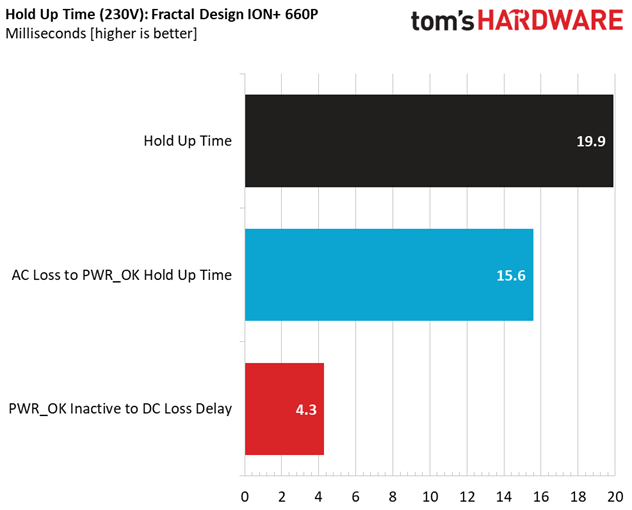
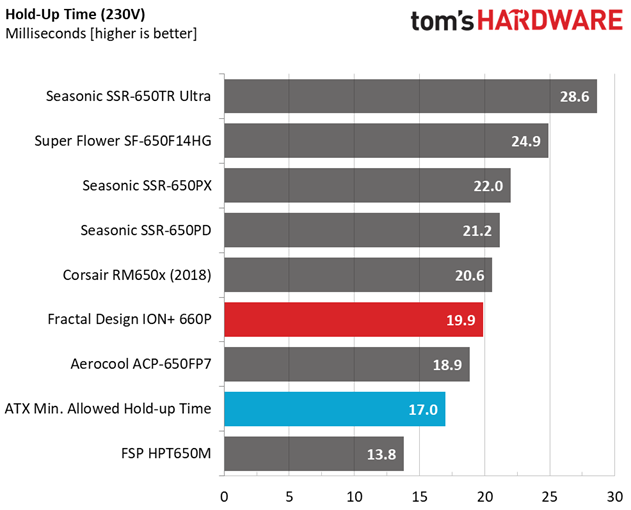
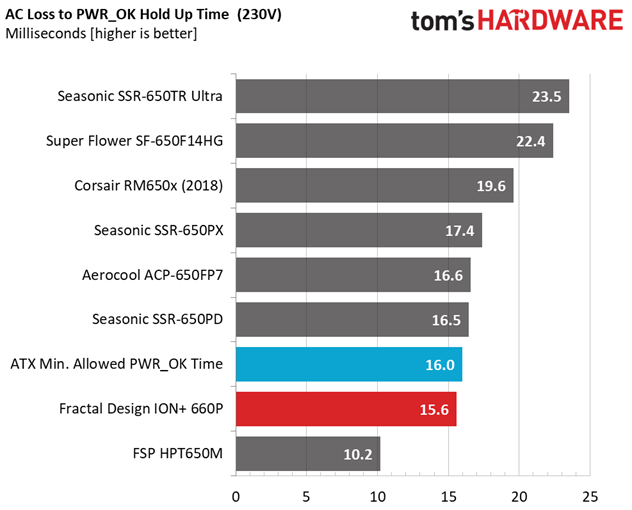
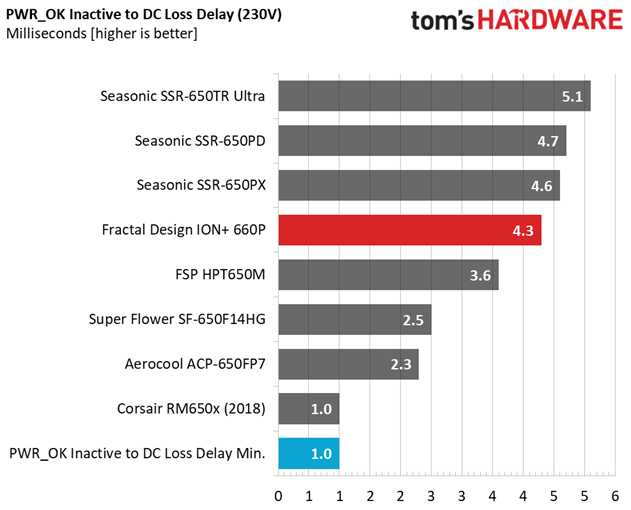
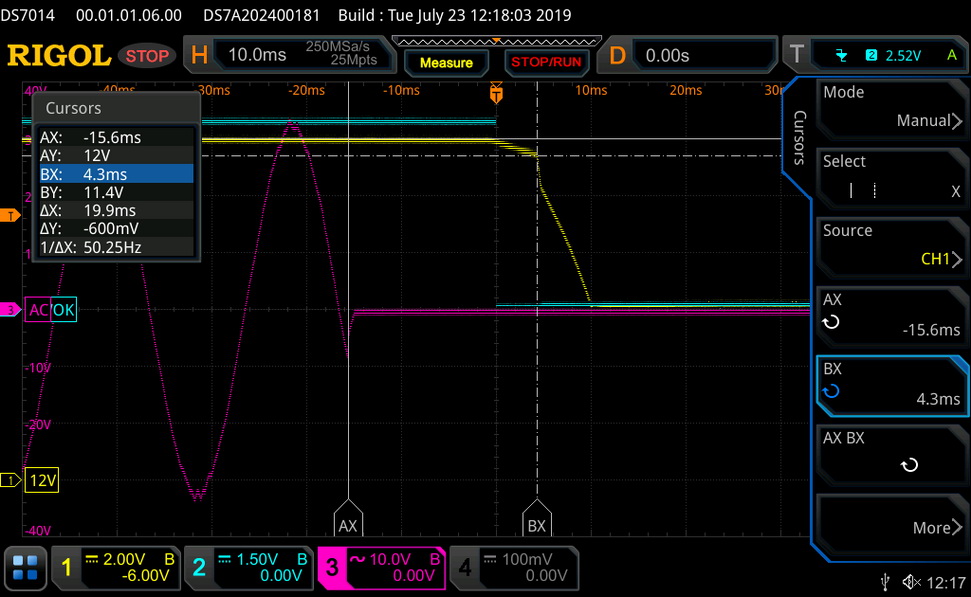
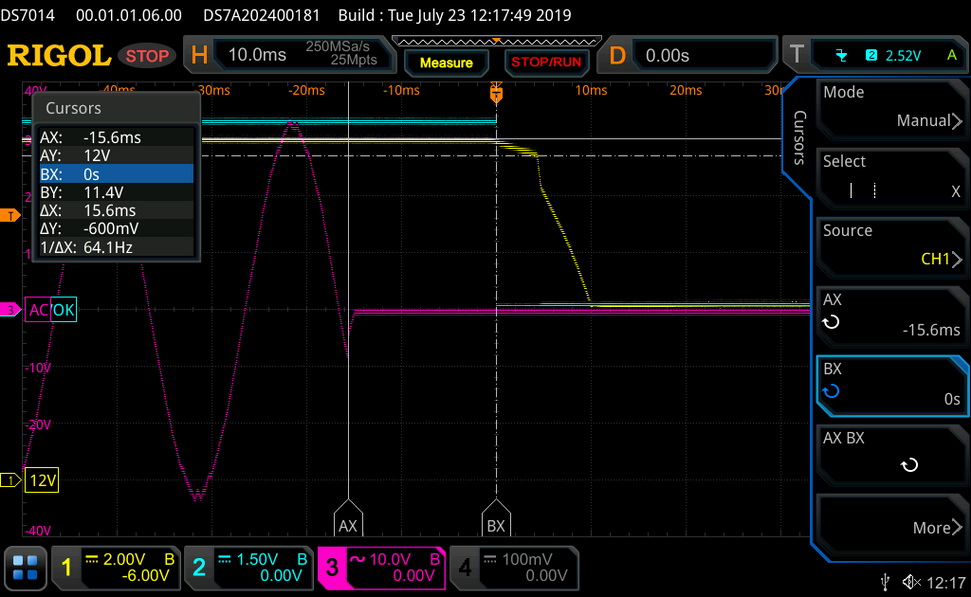
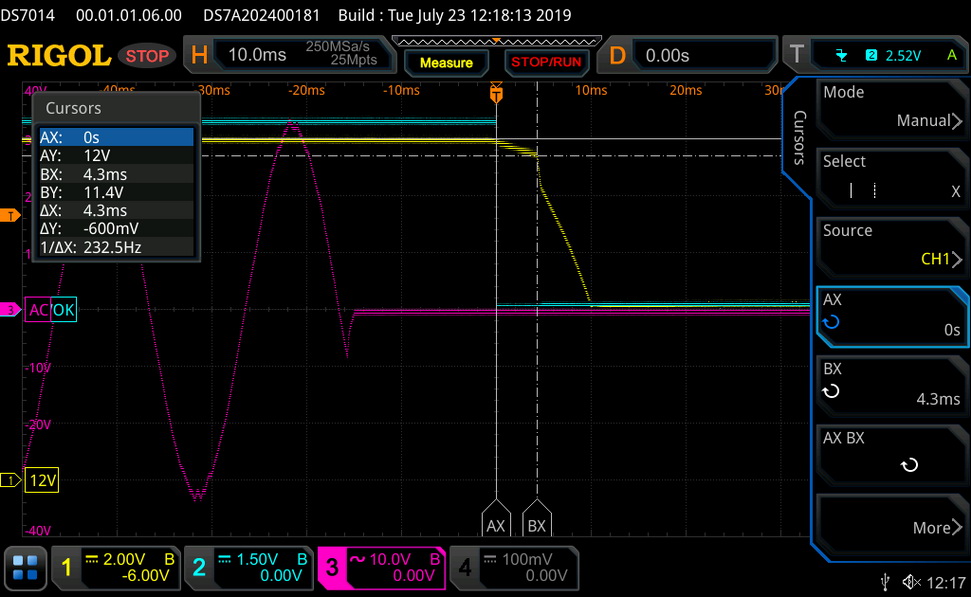
The hold-up time is quite long, but the power ok signal's hold-up time is a little lower than 16ms, which is the period that the ATX spec requires.
Inrush Current
Inrush current, or switch-on surge, refers to the maximum, instantaneous input current drawn by an electrical device when it is first turned on. A large enough inrush current can cause circuit breakers and fuses to trip. It can also damage switches, relays, and bridge rectifiers. As a result, the lower the inrush current of a PSU right as it is turned on, the better.
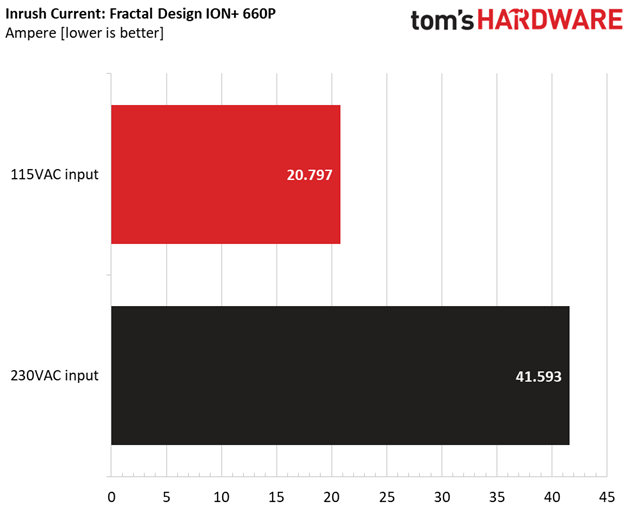
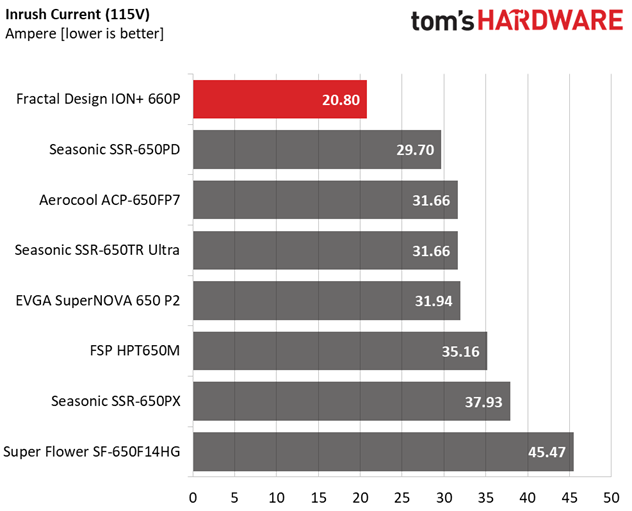
Low inrush currents with both voltage inputs.
Get Tom's Hardware's best news and in-depth reviews, straight to your inbox.
10-110% Load Tests
These tests reveal the Ion+ 660P’s load regulation and efficiency levels under high ambient temperatures. They also show how the fan speed profile behaves under increased operating temperatures.
| Test # | 12V | 5V | 3.3V | 5VSB | DC/AC (Watts) | Efficiency | Fan Speed (RPM) | PSU Noise (dB[A]) | Temps (In/Out) | PF/AC Volts |
|---|---|---|---|---|---|---|---|---|---|---|
| 1 | 3.675A | 1.990A | 1.991A | 1.000A | 65.746 | 86.875% | 0 | <6.0 | 44.25°C | 0.963 |
| 12.011V | 5.029V | 3.314V | 5.001V | 75.679 | 39.45°C | 115.16V | ||||
| 2 | 8.414A | 2.983A | 2.993A | 1.201A | 131.860 | 90.910% | 0 | <6.0 | 46.03°C | 0.987 |
| 11.998V | 5.032V | 3.306V | 4.999V | 145.044 | 40.61°C | 115.22V | ||||
| 3 | 13.498A | 3.485A | 3.481A | 1.403A | 197.787 | 91.994% | 0 | <6.0 | 47.79°C | 0.994 |
| 11.985V | 5.027V | 3.302V | 4.989V | 215.001 | 41.56°C | 115.17V | ||||
| 4 | 18.587A | 3.983A | 4.001A | 1.608A | 263.788 | 92.030% | 384 | 6.8 | 41.84°C | 0.994 |
| 11.975V | 5.024V | 3.298V | 4.977V | 286.634 | 48.41°C | 115.15V | ||||
| 5 | 23.356A | 4.985A | 4.995A | 1.813A | 329.912 | 91.850% | 387 | 6.9 | 42.17°C | 0.996 |
| 11.963V | 5.017V | 3.302V | 4.965V | 359.186 | 49.62°C | 115.16V | ||||
| 6 | 28.140A | 5.989A | 6.010A | 2.020A | 396.029 | 91.233% | 425 | 7.4 | 42.54°C | 0.997 |
| 11.948V | 5.011V | 3.294V | 4.953V | 434.087 | 50.40°C | 115.14V | ||||
| 7 | 32.934A | 6.998A | 7.030A | 2.228A | 462.153 | 90.666% | 722 | 18.4 | 43.07°C | 0.998 |
| 11.934V | 5.003V | 3.286V | 4.940V | 509.732 | 51.21°C | 115.15V | ||||
| 8 | 37.746A | 7.995A | 8.030A | 2.431A | 528.277 | 90.044% | 822 | 21.4 | 43.74°C | 0.998 |
| 11.918V | 5.005V | 3.288V | 4.937V | 586.689 | 52.66°C | 115.15V | ||||
| 9 | 42.963A | 8.503A | 8.527A | 2.433A | 593.996 | 89.485% | 977 | 26.7 | 44.40°C | 0.998 |
| 11.905V | 5.000V | 3.284V | 4.934V | 663.796 | 53.77°C | 115.16V | ||||
| 10 | 47.963A | 9.017A | 9.064A | 3.061A | 660.013 | 88.773% | 1119 | 30.8 | 45.80°C | 0.998 |
| 11.890V | 4.993V | 3.277V | 4.903V | 743.487 | 55.59°C | 115.15V | ||||
| 11 | 53.581A | 9.022A | 9.070A | 3.063A | 726.058 | 88.066% | 1122 | 31.0 | 46.62°C | 0.998 |
| 11.876V | 4.990V | 3.275V | 4.899V | 824.451 | 57.46°C | 115.16V | ||||
| CL1 | 0.154A | 13.002A | 13.000A | 0.000A | 109.741 | 84.213% | 0 | <6.0 | 49.74°C | 0.984 |
| 11.973V | 5.016V | 3.283V | 5.058V | 130.313 | 42.25°C | 115.21V | ||||
| CL2 | 55.038A | 1.003A | 1.000A | 1.000A | 668.412 | 89.434% | 1118 | 30.8 | 45.38°C | 0.998 |
| 11.903V | 5.005V | 3.300V | 4.975V | 747.378 | 55.12°C | 115.20V |
The unit can easily handle high operating temperatures, without increasing its fan speed. Another thing that makes an impression is the fan's low startup voltage, which allows for very slow rotation speeds.
20-80W Load Tests
In the following tests, we measure the Ion+ 660P's efficiency at loads significantly lower than 10% of its maximum capacity (the lowest load the 80 PLUS standard measures). This is important for representing when a PC is idle with power-saving features turned on.
| Test # | 12V | 5V | 3.3V | 5VSB | DC/AC (Watts) | Efficiency | Fan Speed (RPM) | PSU Noise (dB[A]) | PF/AC Volts |
|---|---|---|---|---|---|---|---|---|---|
| 1 | 1.205A | 0.498A | 0.482A | 0.199A | 19.649 | 50.174% | 0 | <6.0 | 0.906 |
| 12.068V | 5.036V | 3.312V | 5.034V | 39.162 | 115.16V | ||||
| 2 | 2.475A | 0.996A | 0.994A | 0.399A | 40.043 | 81.859% | 0 | <6.0 | 0.934 |
| 12.014V | 5.029V | 3.316V | 5.021V | 48.917 | 115.16V | ||||
| 3 | 3.673A | 1.491A | 1.478A | 0.598A | 59.526 | 86.109% | 0 | <6.0 | 0.959 |
| 12.015V | 5.033V | 3.308V | 5.019V | 69.129 | 115.16V | ||||
| 4 | 4.942A | 1.990A | 1.992A | 0.799A | 79.951 | 88.710% | 0 | <6.0 | 0.972 |
| 12.009V | 5.027V | 3.312V | 5.006V | 90.126 | 115.16V |
The efficiency with 20W load is very low.Strangely enough even the Ion+ 860P performed better at this load level.
2% or 10W Load Test
Intel plans on raising the ante at efficiency levels under ultra-light loads. So from July 2020, the ATX spec will require 70% and higher efficiency with 115V input. The applied load is only 10W for PSUs with 500W and lower capacities, while for stronger units we dial 2% of their max-rated-capacity.
| Test # | 12V | 5V | 3.3V | 5VSB | DC/AC (Watts) | Efficiency | Fan Speed (RPM) | PSU Noise (dB[A]) | PF/AC Volts |
|---|---|---|---|---|---|---|---|---|---|
| 1 | 0.924A | 0.223A | 0.220A | 0.050A | 13.267 | 42.959% | 0 | <6.0 | 0.871 |
| 12.078V | 5.038V | 3.324V | 5.039V | 30.883 | 115.17V |
The efficiency with 2% load is bottom low. Normally it should be higher than 60%, at least. Again the Ion+ 860P achieved higher efficiency, almost 50%, in this test.
Efficiency
Next, we plotted a chart showing the Ion+ 660P’s efficiency at low loads, and loads from 10 to 110% of its maximum-rated capacity. The higher a PSU’s efficiency, the less energy goes wasted, leading to a reduced carbon footprint and lower electricity bills.
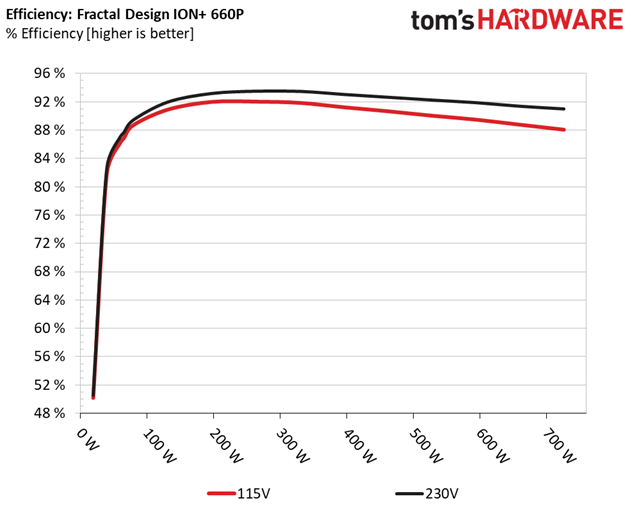
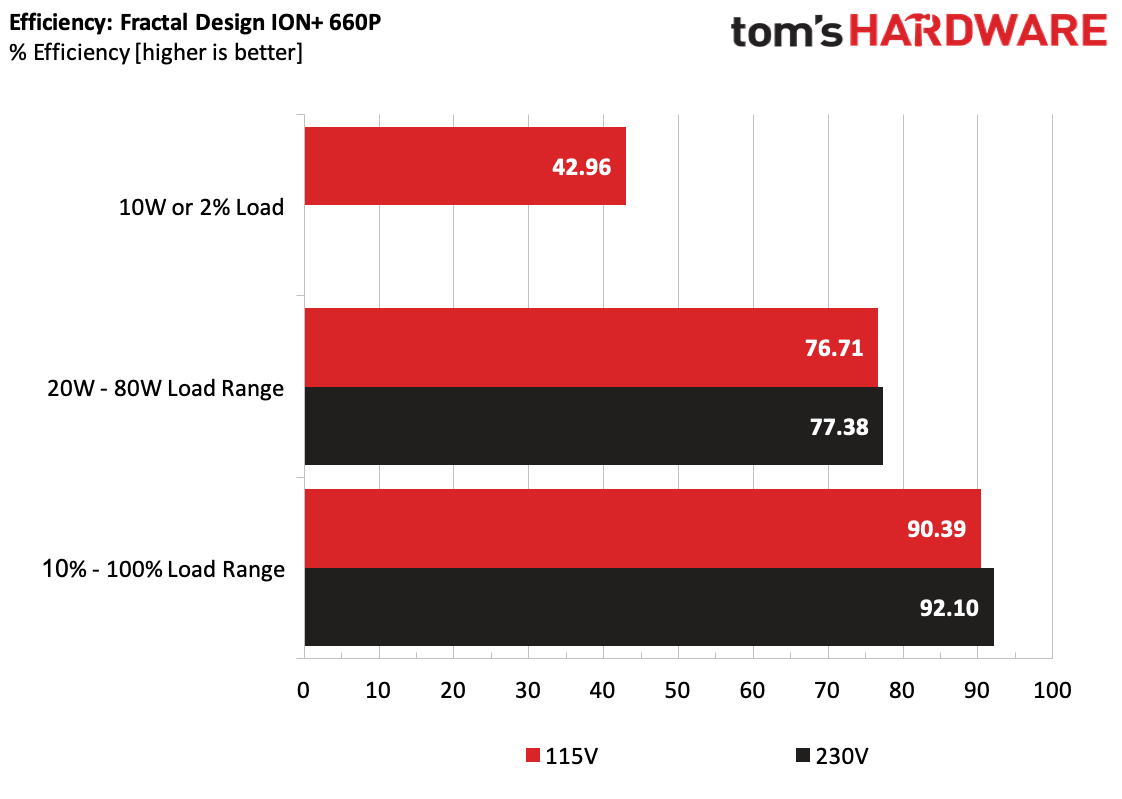
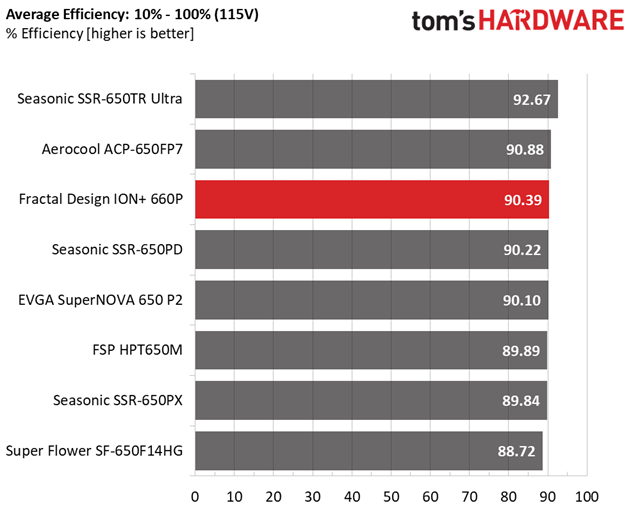
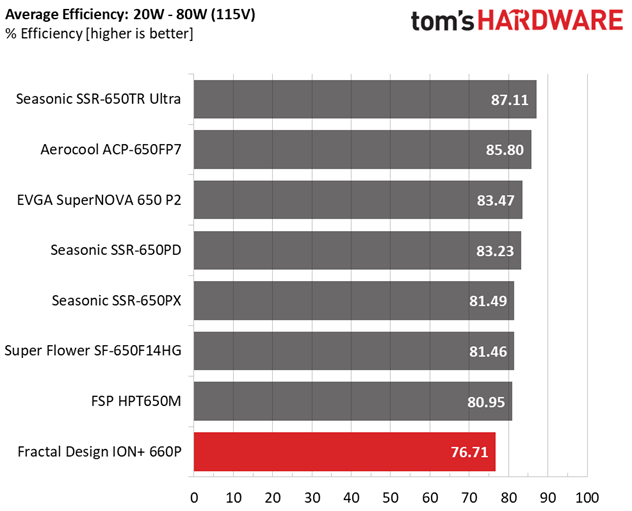
The efficiency with normal loads is good, but this is not the case with light loads.
5VSB Efficiency
| Test # | 5VSB | DC/AC (Watts) | Efficiency | PF/AC Volts |
|---|---|---|---|---|
| 1 | 0.100A | 0.511 | 68.775% | 0.104 |
| 5.112V | 0.743 | 115.14V | ||
| 2 | 0.250A | 1.276 | 74.839% | 0.205 |
| 5.106V | 1.705 | 115.14V | ||
| 3 | 0.550A | 2.801 | 76.719% | 0.319 |
| 5.093V | 3.651 | 115.13V | ||
| 4 | 1.000A | 5.074 | 77.525% | 0.392 |
| 5.073V | 6.545 | 115.13V | ||
| 5 | 1.500A | 7.578 | 77.739% | 0.431 |
| 5.051V | 9.748 | 115.13V | ||
| 6 | 3.000A | 14.940 | 77.026% | 0.482 |
| 4.980V | 19.396 | 115.13V |
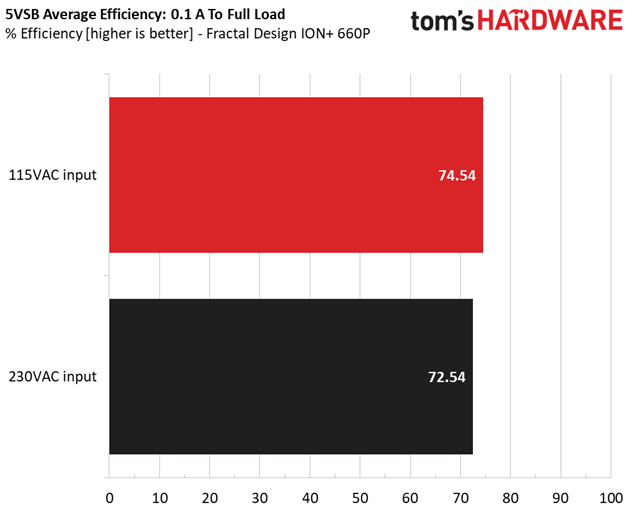
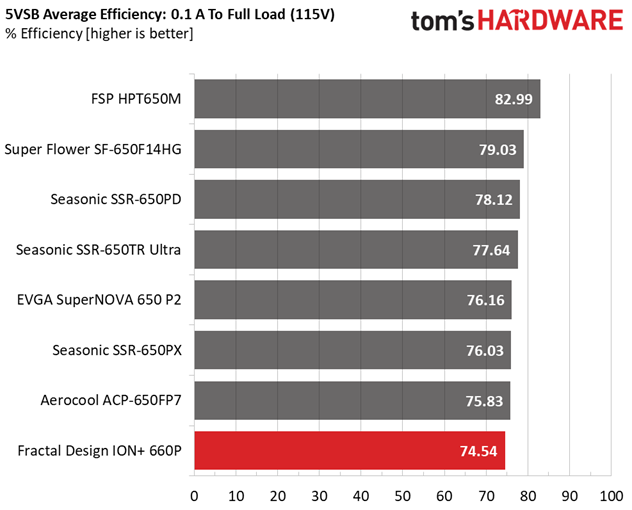
The 5VSB rail isn't so efficient. Please do note that in the charts above we average the readings of the #1, #2, #4 and #6 tests, to retain compatibility with previous results.
Power Consumption In Idle And Standby
| Mode | 12V | 5V | 3.3V | 5VSB | Watts | PF/AC Volts |
|---|---|---|---|---|---|---|
| Idle | 12.097V | 5.049V | 3.314V | 5.049V | 6.060 | 0.446 |
| 115.1V | ||||||
| Standby | 0.103 | 0.015 | ||||
| 115.1V |
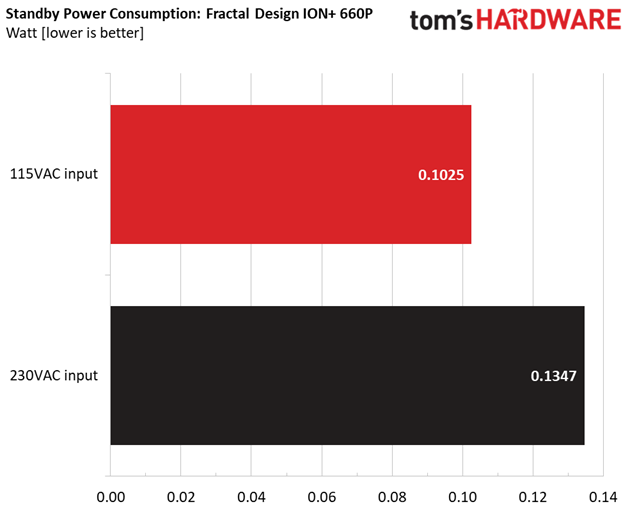
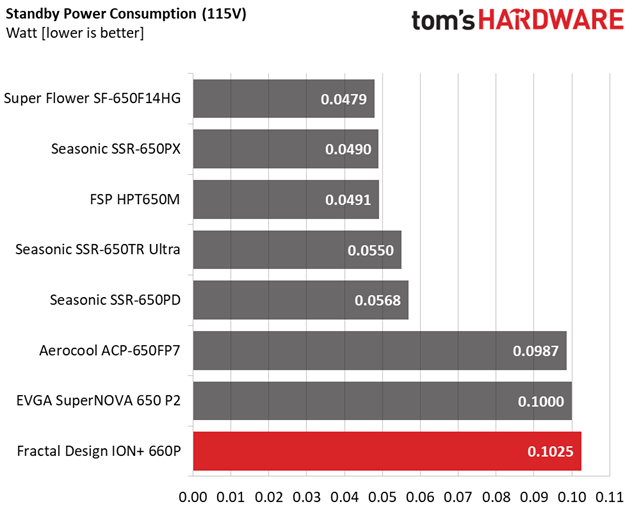
Fan RPM, Delta Temperature, And Output Noise
All results are obtained between an ambient temperature of 36 to 45 degrees Celsius (96.8 to 113 degrees Fahrenheit).
The fan profile is highly relaxed, with the maximum fan speed barely exceeding 1100 RPM.
The following results were obtained at 30 to 32 degrees Celsius (86 to 89.6 degrees Fahrenheit) ambient temperature.
This is a very quiet power supply. Under normal operating conditions, the noise will never exceed 25 dB(A).
MORE: Best Power Supplies
MORE: How We Test Power Supplies
MORE: All Power Supply Content
Current page: Load Regulation, Hold-Up Time, Inrush Current, Efficiency and Noise
Prev Page Specifications and Part Analysis Next Page Protection Features, DC Power Sequencing, Cross-Load Tests and Infrared Images
Aris Mpitziopoulos is a contributing editor at Tom's Hardware, covering PSUs.
-
redgarl Sooo... anandtech is having the exact opposite conclusion and even calling it the best Stirfa PSU series... are you even knowing what you are doing?Reply
https://www.anandtech.com/show/14693/the-fractal-design-ion-760p-80plus-platinum-psu-review/5
Electrically, the Ion+ 760P positively surprised us. As soon as we noticed that it is a design originating from Sirfa (High Power), we believed that most of the electrical figures would end up being mediocre, as Sirfa usually designs products that are competitive in terms of value, not performance. The Ion+ 760P is an entirely different story, delivering outstanding power quality across the entire load range and under any operating conditions, easily competing toe-to-toe with any other top-tier unit that we've reviewed so far. Furthermore, not only it is very efficient under normal circumstances, but it's able to maintain its exceptional energy conversion efficiency figures even when the ambient temperature gets very high. -
Aris_Mp Yes, I know very well what I am doing and if you bother to read the review and the provided data, you will also get an idea.Reply -
Carabyte This PSU has very low EMI compared to other's I'm seeing on your site. Do you have a page with the EMI chart for every PSU? I'd like to know what's the lowest EMI PSU you have found at 650-750Watt range. Meaning overall the least peaks, smooth and lowest peak. This one looks quite good, is it one of the best?Reply
Thanks!
Aris_Mp said:Yes, I know very well what I am doing and if you bother to read the review and the provided data, you will also get an idea.
